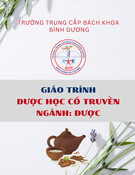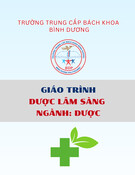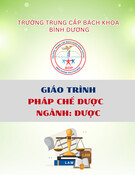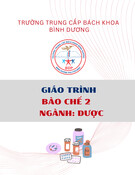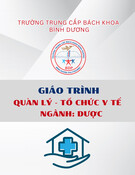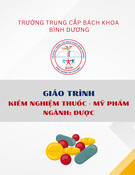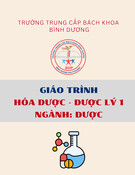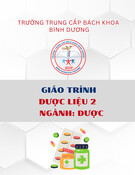
Uyen To Pham et al. HCMCOUJS-Engineering and Technology, 14(2), 39-47 39
Evaluating antibacterial efficacy of extracts from Ludwigia hyssopifolia
against pathogenic bacteria
Uyen To Pham1, Y Thi Nhu Hoang1, Bao Le1*
1Ton Duc Thang University, Ho Chi Minh City, Vietnam
*Corresponding author: lebao@tdtu.edu.vn
ARTICLE INFO
ABSTRACT
DOI:10.46223/HCMCOUJS.
tech.en.14.2.3014.2024
Received: October 13th, 2023
Revised: November 04th, 2023
Accepted: November 28th, 2023
Keywords:
antibacterial activity; extract;
flavonoid; Ludwigia
hyssopifolia; phenolics
Ludwigia hyssopifolia extracts have historically been
consumed as a healthful drink and rich in biomass. Therefore, the
aims of this study were to determine the most effective
fractionated extracts of L. hyssopifolia against pathogens. The
whole plants of L. hyssopifolia were extracted various fractions
with methanol, hexane, chloroform, ethyl acetate, and aqueous.
The total phenolics and flavonoids was screened using quantitative
approaches. The extracts tested for antibacterial activity against
pathogens, including Bacillus cereus, Staphylococcus aureus,
Escherichia coli, Salmonella Typhi, and Helicobacter pylori
through the agar diffusion technique and the microtiter broth
dilution method. The largest yield was obtained from the aqueous
fractional extract. The phytochemical composition discovered in
ethyl acetate was more abundant in phenolics and flavonoid
compounds. Fractionation enhanced the antibacterial effect of the
extract. The extracts showed a broad spectrum of antibacterial
activity against all the bacteria tested, particularly H. pylori. In
parallel, ethyl acetate extract showed antibacterial activity. The
current results could provide rational support for the traditional
use of L. hyssopifolia to treat infectious diseases and provide data
for developing natural products.
1. Introduction
Ludwigia hyssopifolia is a semi-terrestrial plant belonging to the Onagraceae family
(Raven, 1974). The plants are found in moist lands and have been used to prepare dishes in
Asian countries (Chauhan, Pame, & Johnson, 2011). Ludwigia sp. is an annual herbaceous plant
(living for 01 year) and grows abundantly in the Central and Southern provinces, from Hue
outward to the Mekong Delta provinces (Nguyen, Huynh, Pham, Phan, & Nguyen, 2020).
Ludwigia leaves rich in phytochemical compounds, such as polyphenolics, terpenoids, and
saponin with biological properties (Das, Kundu, Bachar, Uddin, & Kundu, 2007; Mangao,
Arreola, Gabriel, & Salamanez, 2020; Rao, Merugu, & Atthapu, 2013; Shawky, Elgindi, &
Hassan, 2023). The methanol extract of L. hyssopifolia exerts anti-diarrheal activity by reducing
diarrhea episodes in mice (Shaphiullah et al., 2003). While the ethyl acetate extract of L.
hyssopifolia with the alkaloid component 1-[5-(1,3-benzodioxol-5-yl)- 1-oxo-2,4-entadienyl]
piperidine, commonly known as piperine showed potential antitumor and antibacterial activity
(Das et al., 2007). Kundu, Das, Kundu, and Bachar (2014) published a model to determine the
anti-inflammatory, analgesic, and diuretic activities of L. hyssopifolia. In Vietnam, L.
hyssopifolia is used to treat colds, fever, pharyngitis, stomatitis, enteritis, diarrhea, sprue,
dysentery, and is used externally to treat (Chi, 1997).

40 Uyen To Pham et al. HCMCOUJS-Engineering and Technology, 14(2), 39-47
Antibacterial agents are one of the important and effective therapies for treating diseases
caused by microbial infections (Belete, 2019). However, indiscriminate use of antibiotics leads
to the emergence and spread of multidrug resistant (MDR) strains among bacterial pathogens,
which significantly reduces or sometimes completely neutralizes the effectiveness of antibiotics
(Jubair, Rajagopal, Chinnappan, Abdullah, & Fatima, 2021). Thus, under pressure from rapid
MDR spreading globally, it is paramount to identify products with antibacterial properties in
parallel with finding new treatment methods that do not depend on drugs. Following the
recommendations proposed by the World Health Organization (WHO) on the use of medicinal
plants to treat bacterial injection may exert better outcomes and duration of effect than
commercial antibiotic drugs (Organization, 2019). Secondary metabolites produced in plants
plays a major role in defense against herbivores and microbes (Taylor, 2013; Wink, Ashour, &
El-Readi, 2012).
Ludwigia genus has been shown to possess broad spectrum antimicrobial activities.
Thus, Oyedeji, Oziegbe, and Taiwo (2011) studied the effect of extracts of L. abyssinica and L.
decurrens leaves on the inhibition growth of clinically important species of bacteria and fungi.
They showed the highest Minimum Inhibitory Concentration (MIC) of n-butanol and ethyl
acetate extracts on bacteria species. Yakob, Sulaiman, and Uyub (2012) study the MIC and
Minimal Bactericidal Concentration (MBC) of twelve extracts of L. octovalvis on Escherichia
coli O157:H7. Results showed that leaf extracts showed a strong effect on resistance
Escherichia coli strain, whereas root extracts were against Pseudomonas aeruginosa.
However, there is still no study that comprehensively demonstrates the influence of different
extracts on the antibacterial ability of L. hyssopifolia.
L. hyssopifolia is widely used as a traditional medicine for treating various diseases. For
that evidence, our current study aims to contribute to the knowledge of different extracts from L.
hyssopifolia, to understand the relationship between its phytochemical compounds and in
vitro antibacterial activity against the most common bacterial pathogens.
2. Materials and methods
2.1. Speciments and extract preparation
The plants were identified by taxonomists (Dr. Dang Van Son) of the Institute of Tropical
Biology, Ho Chi Minh City, Vietnam. After authentication, fresh aerial parts of the matured
plants were collected in bulk from the rice-cultivating area in Go Vap District, Ho Chi Minh
City, Vietnam, in February 2022, washed, shaded dried, and then milled into coarse powder by a
mechanical grinder. After grinding, the plant supernatant was extracted by sequential extraction
procedure using methanol (MRM), hexane (HRM), chloroform (CRM), ethyl acetate (EARM)
and aqueous (DRM). Each solvent extraction was done in the ratio of 1:25 (v/v), and then, the
mixture was filtered through Whatman No. 42 filter paper, and the organic matter was re-
extracted two additional times under the same conditions. Each extract was then evaporated
under reduced pressure at 45°C to yield the following equation:
( )
(1)
The dried extract was stored in a desiccator till further study.

Uyen To Pham et al. HCMCOUJS-Engineering and Technology, 14(2), 39-47 41
2.2. Quantification of total phenolics and total flavonoid
For the determination of the total phenolic (TPC) and flavonoid (TFC) contents, the
extracts were solubilized in methanol or DMSO (1 mg/mL) and filtered through a 0.45μm filter.
The AlCl3 method was applied in our study to determine the total amount of flavonoid content.
In brief, 500μL of a serially diluted sample solution (6.25 - 400 μg/mL) was diluted with 3ml of
distilled water and then 300μL of 5% NaNO2 was added and allowed to stand for 05min. Then,
600μL of 10% AlCl3 was added. After 06min, 2mL of 1M NaOH was added, and the absorbance
was measured at 510nm vs. the reagent blank. The Total Flavonoid Content (TFC) was then
calculated using a standard calibration curve, prepared from quercetin, and expressed as mg of
quercetin equivalent (QAE) per gram of extract. The Folin-Ciocalteu method was used to
determine the total amount of phenolic content. In detail, 800μL of a serial diluted sample
solution (6.25 - 400 μg/mL) was mixed with 100μL Folin-Ciocalteu reagent in a microtube.
After 05 minutes of incubation, 100μL of 20% sodium carbonate was added, and the mixture
was allowed to stand for 30 minutes protected from light. The absorption was measured at
725nm using a UV spectrophotometer (UV-1800, Shimadzu Co., Kyoto, Japan). The TPC was
expressed in terms of mg of Gallic Acid Equivalent (GAE) per gram of extract.
2.3. Microbial strains and culture media
The five different human pathogenic bacterial strains were tested, including Bacillus
cereus KACC 11240, Staphylococcus aureus KCCM 11335, Escherichia coli K99, Salmonella
Typhi KACC 10764, and Helicobacter pylori 51932. These tested strains were subcultured and
stored in Mueller Hinton Agar (MHA) media at 4°C until analysis.
2.4. Determination of zone of inhibition
To screen the antibacterial activity of extracts, the tested strain was inoculated in Muller
Hinton Broth (MHB) to adjust the turbidity equal to 0.5 McFarland standard (1.5 × 108
CFU/mL). The MHA plate was then swabbed with standardized microbial culture broth. Five
wells of 6mm were punched in the inoculated media using a sterile borer. Each well was filled
with 50μL extracts from diluted extracts and Kanamycin 50 mg/mL as positive control. It was
allowed to diffuse for about 30 minutes at room temperature and incubated for 24 hours at 37°C.
After incubation, plates were observed for the formation of a clear zone around the well, which
corresponds to the antimicrobial activity of tested extracts. The diameter of inhibitory zones (in
mm) formed around each well was measured in mm.
2.5. Determination of MIC and MBC
To verify the antibacterial activity of extracts, the broth microdilution method was used
to determine the MIC according to Clinical and Laboratory Standards Institute (CLSI). A set of
two-fold serial dilutions of extracts (100μL) and Mueller Hinton Broth (100μL) was placed in a
microtiter plate to obtain various concentrations. The bacterial suspension (turbidity equal to
0.25 McFarland standard) was put into each well and mixed thoroughly. The plate was sealed
and incubated aerobically at 37°C. Following 24h incubation, 0.01% sterile resazurin solution
(20μL) was added for colour development. MIC is defined as the lowest extract concentration
which could retard the multiplication of the tested bacteria. The MBC values of the extracts were
recorded as the lowest concentration that showed no visible growth.

42 Uyen To Pham et al. HCMCOUJS-Engineering and Technology, 14(2), 39-47
2.6. Statistical analysis
All the determinations were performed in triplicate. The statistical analysis was
performed using GraphPad Prism 9. The significance level was chosen before performing the
statistical analysis (α = 0.05).
3. Results and discussion
3.1. Chemical profile
Liquid-liquid partition is a critical analytical technique in extraction/purification/
separation of the bioactive secondary metabolites, which are often present in low quantities in
plant material. In this study, the yield of crude extract (MRM) of the Ludwigia hyssopifolia
leaves was 9.45% w/w, which was calculated based on the weight of dried plant material (Table
1). Liquid-liquid partition for HRM, CRM, EARM, and DRM produced approximately 15.61%,
5.49%, 6.94%, and 30.23% yields, respectively (Table 1). The yield of the aqueous fraction
(30.23%) was the highest among the four fractions, which was calculated based on the weight of
the crude MRM extract used (Reddy et al., 2021).
Table 1
Extraction yields and obtains dry weights of Ludwigia hyssopifolia extract and its partitioned fractions
Extracts
Yields (%)
MRM
9.45
HRM
15.61
CRM
5.49
EARM
6.94
DRM
30.23
Note: Values are presented as means. MRM, crude methanol extracts; HRM, hexane extract; CRM, chloroform
extract; EARM, ethyl acetate extract; DRM, aqueous extract
Based on the results obtained by colorimetric assays for evaluating the total contents of
phenolic and flavonoid in the tested extracts. A noteworthy difference in total phenolic and
flavonoid contents between five solvent extracts was observed in Table 2. Among the partition
extracts, the EARM extract exhibited the highest level of total phenolics, with a value of
464.8mg GAE/g, followed by ethanol (305.3mg GAE/g), aqueous (183.4mg GAE/g), chloroform
(171.4mg GAE/g), and n-hexane (40.7mg GAE/g). The EARM was also significantly (p > 0.05)
richest in total flavonoid content (156.9mg RE/g) compared to other partition extracts. The total
flavonoid content of the four fractions of the partitioned extract was different and decreased in
the following order: CRM > MRM > DRM > HRM (p > 0.05). In recent reports, phytochemical
screening showed that the members of the genus Ludwigia extracts contained phenolic
compounds, flavonoids, condensed tannins, and alkaloid in different parts, which agrees with our
result. Besides that, it was reported by Mangao et al. (2020) that the total phenol content in the
aqueous extracts from the leaf of L. hyssopifolia was 26.66mg GAE/g, therefore lower than that
showed in our study. Similarly, the total phenolic and flavonoid contents were reported by
Praneetha, Reddy, and Kumar (2018) as 29.6mg GAE/g and 70.2mg RE/g in the methanol-based

Uyen To Pham et al. HCMCOUJS-Engineering and Technology, 14(2), 39-47 43
lyophilized extract. Environmental differences such as geographical and climatic conditions may
contribute to the differences between these studies.
Table 2
Total phenolic and flavonoid content of Ludwigia hyssopifolia
Extracts
TPC (mg GAE/g)
TFC (mg RE/g)
MRM
305.3 ± 0.96b
28.3 ± 1.49c
HRM
40.7 ± 0.61e
4.8 ± 2.70e
CRM
171.4 ± 0.83d
35.0 ± 1.43b
EARM
464.8 ± 0.52a
156.9 ± 2.70a
DRM
183.4 ± 0.83c
15.2 ± 2.18d
Note: Values are mean ± SD (n = 3), and with different superscripts in lowercase alphabets in the same column are
significantly different (p < 0.05). TPC, total phenolic content; TFC, total flavonoid content; GAE, gallic acid
equivalent; RE, rutin equivalent
3.2. Antibacterial activity
Figure 1 illustrates the anti-bacterial activity of different extracts of L. hyssopifolia in terms
of zones of inhibition, as investigated under the agar well diffusion method against pathogens,
which are tabulated in Table 3. Different extractives of L. hyssopifolia were screened against
human pathogenic organisms to evaluate antibacterial activities by disc diffusion method. Among
different fractions tested, ethyl acetate fraction of the L. hyssopifolia exhibited moderate inhibitory
activity (4.5 - 15mm) followed by methanol fraction (5.5 - 12.5mm) whereas the hexane fraction
showed little activity on the tested microorganisms. The most sensitivity was observed in B. cereus
(15mm) and H. pylori (13.5mm) by ethyl acetate fraction of the L. hyssopifolia.
Figure 1. The inhibitory zone again Bacillus cereus in different extracts of L. hyssopifolia

![Bài giảng Dược động học [chuẩn nhất]](https://cdn.tailieu.vn/images/document/thumbnail/2025/20251122/s236884@nctu.edu.vn/135x160/93751763955471.jpg)



